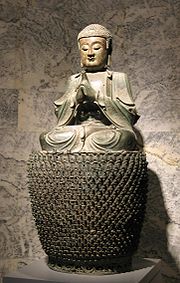
Brahmajala Sutra (Mahayana)
Encyclopedia

Mahayana
Mahāyāna is one of the two main existing branches of Buddhism and a term for classification of Buddhist philosophies and practice...
Buddhist canon. It is not related to the Brahmajala Sutta
Brahmajala Sutta
The Brahmajala Sutta is the first of 34 suttas in the Digha Nikaya . The name comes from 'brahma' and 'jala'...
of the Theravada
Theravada
Theravada ; literally, "the Teaching of the Elders" or "the Ancient Teaching", is the oldest surviving Buddhist school. It was founded in India...
Buddhist Pali Canon
Pāli Canon
The Pāli Canon is the standard collection of scriptures in the Theravada Buddhist tradition, as preserved in the Pāli language. It is the only completely surviving early Buddhist canon, and one of the first to be written down...
. While the sutra was traditionally regarded as having been recorded in Sanskrit and then translated by Kumarajiva
Kumarajiva
Kumārajīva; was a Kuchean Buddhist monk, scholar, and translator. He first studied teachings of the Sarvastivada schools, later studied under Buddhasvāmin, and finally became a Mahāyāna adherent, studying the Madhyamaka doctrine of Nagarjuna. Kumārajīva settled in Chang'an, which was the imperial...
, scholars now believe that the text was written by unknown authors in China in the mid-5th century CE. The sutra itself claims that it is the final chapter of a much longer Sanskrit text, but there is no clear evidence that such a text ever existed.
This sutra introduces Vairocana
Vairocana
Vairocana is a celestial Buddha who is often interpreted as the Bliss Body of the historical Gautama Buddha; he can also be referred to as the dharmakaya Buddha and the great solar Buddha. In Sino-Japanese Buddhism, Vairocana is also seen as the embodiment of the Buddhist concept of shunyata or...
Buddha and his relation to Shakyamuni Buddha and states the 10 major precepts for Bodhisattvas 十重戒 and the 48 minor precepts one should follow to advance along the path. These precepts came to be treated in China as a higher ethic a monk would adopt after ordination, in addition to the monastic rules. In Japan, they came to displace the monastic rules almost completely starting with Saicho
Saicho
was a Japanese Buddhist monk credited with founding the Tendai school in Japan, based around the Chinese Tiantai tradition he was exposed to during his trip to China beginning in 804. He founded the temple and headquarters of Tendai at Enryaku-ji on Mt. Hiei near Kyoto. He is also said to have...
and the rise of the Tendai
Tendai
is a Japanese school of Mahayana Buddhism, a descendant of the Chinese Tiantai or Lotus Sutra school.Chappell frames the relevance of Tendai for a universal Buddhism:- History :...
sect, so that for example most Japanese clergy are now married. The name of the sutra derives from the vast net
Indra's net
Indra's net is a metaphor used to illustrate the concepts of emptiness, dependent origination, and interpenetration in Buddhist philosophy...
that the god Brahma
Brahma (Buddhism)
' in Buddhism is the name for a type of exalted passionless deity , of which there are several in Buddhist cosmology.-Origins:The name originates in Vedic tradition, in which Brahmā appears as the creator of the universe...
hangs in his palace, and how each jewel in the net reflects the light of every other jewel:
The sutra is also noteworthy for describing who Vairocana Buddha is, as the personification of the Dharma
Dharma
Dharma means Law or Natural Law and is a concept of central importance in Indian philosophy and religion. In the context of Hinduism, it refers to one's personal obligations, calling and duties, and a Hindu's dharma is affected by the person's age, caste, class, occupation, and gender...
itself, or more specifically the Dharmakaya
Dharmakaya
The Dharmakāya is a central idea in Mahayana Buddhism forming part of the Trikaya doctrine that was possibly first expounded in the Aṣṭasāhasrikā prajñā-pāramitā , composed in the 1st century BCE...
or Truth-Body of Buddhism:

